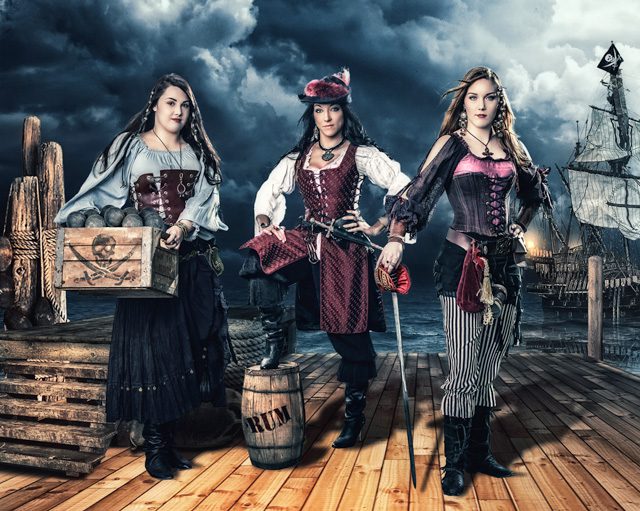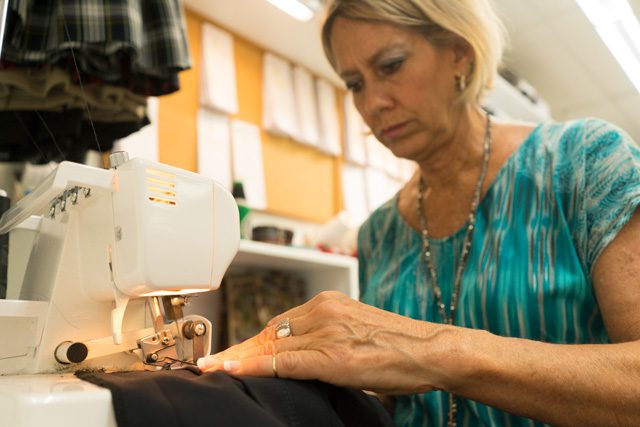
[dropcap]When[/dropcap] you were a child, you may have dressed up and imagined that you were a princess, superhero, fairy, warrior or your favorite cartoon character. Sometimes it was for Halloween, other times it was fun with friends, or merely because you wanted to be that character. The idea of being something you aren’t in everyday life – like a specific crime-fighting icon – was exciting.
But for some, that enjoyment didn’t end with childhood.
While costume play, commonly known as cosplay, is usually inspired by those feelings that some had as children, or a love of a particular character or fandom, it is more than just dressing up. For Heathery Hebert and many others, cosplay is a way to be creative and cultivate a sense of community.
“The main reason I cosplay is for the creative outlet,” says Hebert, a project coordinator in Tulsa who uses the cosplay name of Hikaruhime. “Sitting in front of my sewing machine and zoning out is a form of stress relief for me. I also love the community; meeting new people and getting to discuss aspects of costuming with them and seeing all of the friends I’ve made over the years is a bonus.”
Hikaruhime’s earliest brush with cosplay came in 2005, when she prepared to attend her first convention, Anime Weekend Atlanta. She went as Sailor Star Healer from Sailor Moon, a series of Japanese comics aimed at teenage and young adult readers.
“I’m a type-A person, so I research things very thoroughly,” she says. “While researching what [the Atlanta convention] was like and what people did, I saw several photos of people in costumes and decided I definitely had to do it too.”
The amount of time Hikaruhime puts into creating a costume depends upon what character she chooses, its purpose and where she plans on wearing it. She might spend anywhere from one to five hours making a simple costume and several more on an intricate one.
“If I am making a costume to compete in or wear at a big convention on a highly visible day (Saturday),” she says, “I might select a very complicated costume, and it would not be unusual for me to spend fifty to a hundred hours on the costume.”
For first-time cosplayers, assess the purpose of your costume, Hikaruhime advises. Knowing its purpose will help you decide how hardcore you want to go.
“Learning to create your own cosplay can seem a bit overwhelming at first, but it’s a very rewarding hobby that is sure to boost your self-esteem when you see what you are capable of creating,” she says.
[pullquote]You aren’t going to be perfect right off the bat. Always lean towards learning, and never give up.”[/pullquote]
Kathleen McDonald had a firm foundation of “nerd-dom” that she was willing to grow, which led to her involvement in cosplay. “My whole life, I have been a nerd,” says McDonald, a sales support representative at AT&T in Tulsa. “I can thank my brother for that. At a young age, he got me into comics, superheroes, supervillains and Star Wars. I also always liked to play dress up, especially for Halloween. Then one year, Comic Con came to where I lived, and it just hit me. It was a natural transition and one I quickly fell in love with.”
McDonald has dressed up as everything from the Pokémon Pikachu to Harley Quinn from the Batman comics to her latest persona, Maria, the main character from Ruined My Rhythm, a new graphic novel written by Tulsa author Robert Soul and illustrated by Luna Cooper. She enjoys cosplay for fun, but her real passion is the charity work that she does while costuming.
“I cosplay because I love the charity work I do,” McDonald says. “Seeing little kids smile when I visit the Children’s Hospital at Saint Francis. Having little kids run up to you and tackle hug you when you’re sponsoring an event or a charity is pretty amazing. I live for that happiness that I can create for someone else.”
Cosplay is not limited to a book, a television show, or movie characters. Cosplay can also include time periods, like the Middle Ages or the Renaissance, and you can be short, tall, blue, round or square to participate in the performance art. It is about being the character of your choosing. An experienced cosplayer, like Apple Davies, advises new cosplayers to start small and practice.
“You aren’t going to be perfect right off the bat; I’m still not perfect,” she says. “Always lean towards learning, and never give up.”
Davies, an Oklahoma City marketing assistant, found her calling in cosplay as a teenager but waited until attending the University of Oklahoma to spread her wings.
“I was terrified of being an open geek, so closet geek me waited until college to start making and wearing costumes to events and conventions,” she says. “When I started at OU, I had a few friends that were into the cosplay scene, so I just hung out with them and got sucked in.”
From Pokémon Trainer to Power Girl, Davies has cosplayed a variety of characters. “At first, I did it because my friends were doing it and I thought it was cool,” she says. “Six years deep now, I do it because I love making and creating things, original and replicas. My favorite part is volunteering with Jedi OKC and the DC Marvel League,” which are a Star Wars fan club and a Facebook community, respectively.
Cosplay doesn’t mean you have to be a character that already exists. Karen Renee, a professional designer since 1972, started making elaborate Halloween costumes in 1976. In 2000, she was introduced to a Renaissance festival that took her costume interest to a whole new level. It wasn’t until 2001 that the Tulsan went as an original character with a background in nobility to the Oklahoma Renaissance Festival in Muskogee. She has also portrayed historical figures like Celtic Chieftess Boudicca.

Renee then made clothing and costumes her business. In addition to K. Renee Fairewear, her studio has been actively involved in the school uniform industry for 30 years.
“The cosplay community … is only one aspect of the design work we do at K. Renee’s Design Studio,” she says.
Simple costume undergarments may take Renee only a few hours, but more extravagant ensembles can take as many as 100 hours to complete. The cosplayer chooses how complicated he or she wants the ensemble to be, but accuracy is vital.
“My biggest piece of advice to people interested in creating their outfits is to do your research,” Renee says. “No matter if it is a historical outfit or a fandom cosplay, knowledge of the source material is key. Keep an eye out for details, as these are what make or break your outfit.”
To see the elaborate array of cosplay designs this month, check out the Wizard World Comic Con Tulsa, Oct. 21-23 at the Cox Business Center. You’ll find vendors, cosplayers, artists, games, literature, music, pop culture and anime enthusiasts. If you can’t make that one, other Oklahoma conventions include Izumicon in Oklahoma City, Otaku Matsuri in Norman, the Broken Arrow Comic Con, Tokyo in Tulsa, SoCON in Bixby, SoonerCon in Midwest City, Geekinomicon OKC or Tulsa Comic Expo. If you’re not ready for a conference, get your feet wet by checking out some Oklahoma cosplay groups on Facebook: DC Marvel League, Jedi OKC, All Things Faire or Oklahoma Cosplayers.






















